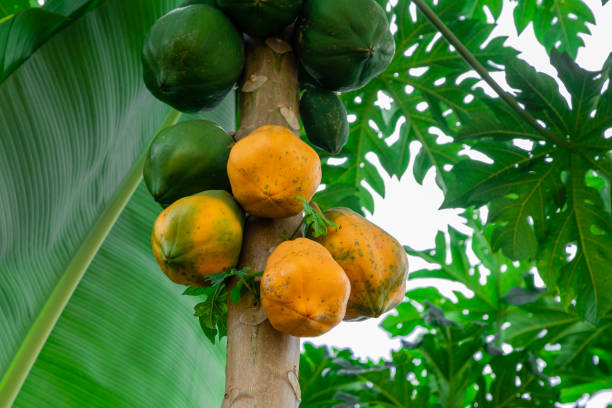
Planting subtropical/tropical trees in the ground requires some planning and preparation to ensure the tree has the best chance of thriving. Here is a step-by-step guide for planting exotics such as Mango, Soursop, Banana, and Papaya in New Zealand, including tips for fertilising and mulching:
Choose the planting site
Choose a site that has good drainage and is not prone to water-logging. Subtropical trees need plenty of sunshine, so choose a spot that receives at least six hours of direct sunlight per day. Also, consider the space required for the tree to grow, and ensure there is adequate room for the tree to spread out.
Consider planting a banana if you are worried about drainage, as they are excellent water pumps. This allows plants like papaya, which are not tolerant of wet feet, to survive better.
Prepare the soil
Subtropical trees require well-draining soil that is rich in nutrients. If your soil is heavy, you may need to amend it with sand or gravel to improve drainage. Add organic matter to the soil, such as compost, manure, or leaf mould, to improve fertility. Dig a hole that is twice as wide and as deep as the root ball of the tree.
Plant the tree
Place the tree in the hole, ensuring that the top of the root ball is level with the surrounding soil. Fill the hole with soil, tamping it down gently to remove any air pockets. Water the tree thoroughly after planting to settle the soil around the roots. For plants susceptible to root rot such as papaya or avocado, consider planting on raised mounds.
Fertilize the tree
Fertilize the tree with a balanced fertiliser, such as 10-10-10, during the growing season. Apply the fertiliser around the base of the tree, following the manufacturer’s instructions. Be careful not to over-fertilize, as this can damage the roots and foliage.
Mulch around the tree
Mulch around the base of the tree with organic mulch, such as wood chips, leaves, or bark. Mulch helps to retain moisture in the soil, suppresses weeds, and adds nutrients to the soil as it decomposes. Apply a layer of mulch that is two to three inches deep, taking care not to cover the trunk of the tree.
Water the tree
Water the tree regularly, especially during dry spells. Subtropical trees require consistent moisture to thrive, so ensure the soil remains moist but not waterlogged. Avoid watering the leaves and foliage of the tree, as this can lead to fungal diseases.
Consider helpful companion plants
Comfrey is perhaps the best all-rounder in NZ. First and foremost, comfrey has deep tap roots that can mine nutrients from deep within the soil and bring them up to the surface where other plants can access them.
Fruiting times for subtropical trees vary depending on the propagation method and growing conditions. In general, it can take two to three years for a subtropical tree to bear fruit. Here are some typical fruiting times based on propagation method:
Mango: Mangos grown from seed can take five to eight years to bear fruit, while grafted trees can bear fruit in two to three years. Please note these are a marginal crop even in the warmest regions but there have been successful trials of mango in Kerikeri.
Pineapple: Pineapples can take up to two years to fruit. Pineapples do not grow well in cold weather, so they are best grown in warm, sheltered spots in New Zealand with excellent drainage. They are commercially grown in Whangarei.
Banana: Bananas grown from suckers can bear fruit in 18 to 24 months, while those grown from seed can take up to five years. Sheltered, well fed bananas will thrive in northern NZ.
Papaya: Papayas can bear fruit in six to nine months from planting, but may take up to a year. More tropical varieties such as Red Lady may take longer but are worth the wait.

Leave a Reply